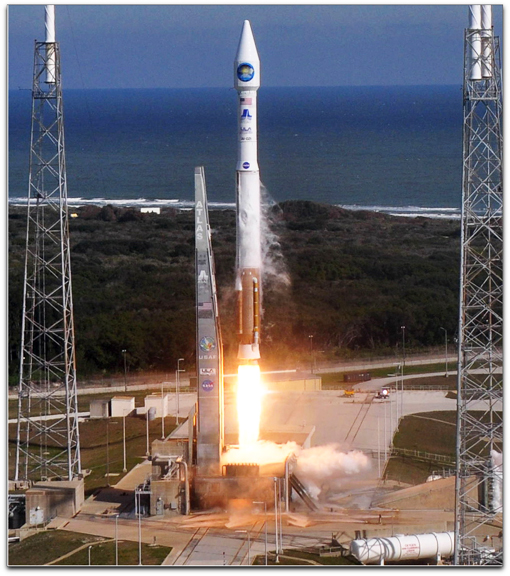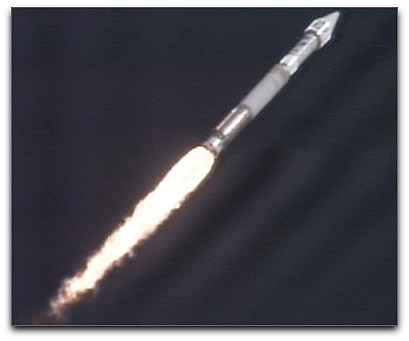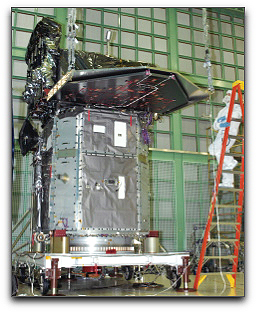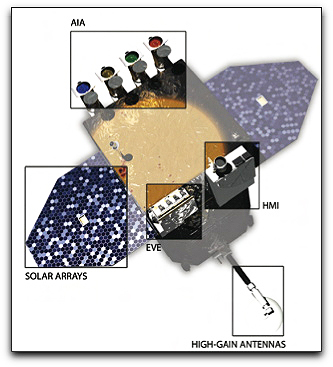 A United Launch Alliance Atlas V with NASA’s Solar Dynamics Observatory launched from its Space Launch Complex-41 launch pad at 10:23 a.m. EST on February 11th. SDO
A United Launch Alliance Atlas V with NASA’s Solar Dynamics Observatory launched from its Space Launch Complex-41 launch pad at 10:23 a.m. EST on February 11th. SDO is the first satellite of
NASA’s
Living with a Star (
LWS) program. Its purpose is to examine the sun, the source of all space weather. The launch photo is courtesy of
Pat Corkery, United Launch Alliance.

he Atlas V rocket carrying the Solar Dynamics Observatory speeds into space shortly after launch Thursday morning from Cape Canaveral Air Force Station in Florida. Photo credit: NASA TV

SDO Assembly at Goddard
The
SDO spacecraft is in good shape midway through the launch phase that will eventually place it in an elongated orbit reaching more than 21,000 miles high. Eventually, SDO's orbit will be circularized and will reach about 22,300 miles in what is called geosynchronous orbit. From that altitude, the spacecraft will point its instruments at the sun and relay the readings instantly to a ground station in New Mexico. The research is expected to reveal the sun's inner workings by constantly taking high resolution images of the sun, collecting readings from inside the sun and measuring its magnetic field activity. This data is expected to give researchers the insight they need to eventually predict solar storms and other activity on the sun that can affect spacecraft in orbit, astronauts on the International Space Station and electronic and other systems on Earth.
SDO will observe the sun, from its deep interior to the outermost layers of solar atmosphere, at the highest ever time cadence. SDO will snap a full disk image in 8 wavelengths every 10 seconds. This rapid cadence led to placing the satellite into an inclined geosynchronous orbit. This allows for a continuous, high-data-rate contact with a dedicated ground station at the White Sands Complex in southern New Mexico. SDO will send down about 1.5 terabytes of data per day, equivalent to
downloading half a million songs each day.

SDO craft and instruments
SDO has three instruments: the
Helioseismic and
Magnetic Imager (
HMI), the
Atmospheric Imaging Assembly (
AIA), and the
Extreme Ultraviolet Variability Experiment (
EVE). Instrument partners
include the
Lockheed Martin Solar & Astrophysics Laboratory of
Lockheed Martin’s
Advanced Technology Center (
AIA),
Stanford University (
HMI), and the
University of Colorado at Boulder (
EVE). SDO will be a major component of the
Heliophysics Great
Observatory, a fleet of science missions developed by the
NASA Heliophysics Division. Each mission concentrates on understanding a different aspect of the sun and its heliosphere — the domain of our sun in the universe.
Topical Tags :
Regional Tags :
 A United Launch Alliance Atlas V with NASA’s Solar Dynamics Observatory launched from its Space Launch Complex-41 launch pad at 10:23 a.m. EST on February 11th. SDO is the first satellite of NASA’s Living with a Star (LWS) program. Its purpose is to examine the sun, the source of all space weather. The launch photo is courtesy of Pat Corkery, United Launch Alliance.
A United Launch Alliance Atlas V with NASA’s Solar Dynamics Observatory launched from its Space Launch Complex-41 launch pad at 10:23 a.m. EST on February 11th. SDO is the first satellite of NASA’s Living with a Star (LWS) program. Its purpose is to examine the sun, the source of all space weather. The launch photo is courtesy of Pat Corkery, United Launch Alliance.




